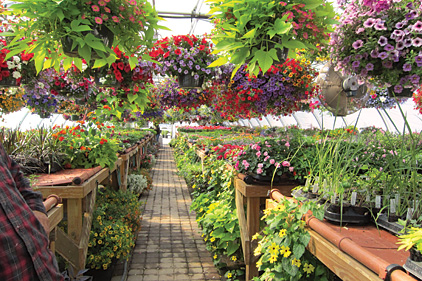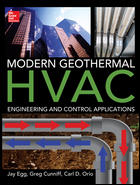
|
| Brownsburg Landscape Co.’s greenhouse is benefiting immensely from the addition of a geothermal heating system. |
According to owner Greg Frazee, the garden center at Brownsburg Landscape Co. LLC is a small business that serves the planting and gardening needs of people in Brownsburg, Ind. Nevertheless, this same small operation is pioneering sustainable growing practices in a big way with the installation of a unique radiant bench heating system that is supported by a geothermal heat pump.
Founded in 1987, Brownsburg Landscape Co. offers a full-service nursery and garden center, complete lawn care and fertilization programs, and an on-site landscape designer. The property includes three greenhouses, one of which is heated and provides growing space for a variety of annuals that support the garden center’s retail operations. Until recently, heat to the 30-by-96-foot aluminum frame and poly structure was provided by a propane-fueled heating system.
“To tell you the truth, I wasn’t in the market for a new heating system,” recalled Frazee. “But when WaterFurnace approached me with a proposal to serve as a field test site for a new method of heating the greenhouse, I felt I had nothing to lose and perhaps something to gain in terms of significant energy savings, so I agreed.”
The WaterFurnace proposal was the brainchild of Jeff Cross, operations project manager at the company. “Part of my job is to think of new applications for our products,” said Cross. “I had given a lot of thought to a greenhouse application that uses geothermal heat to provide radiant heat to the tables on which plants grow. What makes this particular application one of a kind is the fact that we devised a system in which hot water is carried through HyperLoops or tubes in radiant mats on tabletops. Plants sit in pods directly on these mats, so in effect, we are able to provide heat directly to the plants’ roots by concentrating on warming the dirt rather than the air surrounding the plants, which is far more efficient.”
A geothermal system takes advantage of free solar energy stored just below the surface of the earth. Using a series of pipes (an earth loop) buried in the ground and a geothermal or ground-source heat pump, the geothermal heating and cooling system extracts heat from the earth and distributes it through a conventional duct system or a radiant heat system. A closed-loop system circulates a water-based solution through a loop system of small-diameter, high-density polyethylene underground pipes, which can be installed horizontally, vertically, or in a pond.
With a pond located approximately 200 feet from the Brownsburg greenhouse, it made sense to place three HyperLoops in the pond to capture the geothermal energy stored there. A trench about 4-feet deep carries pipes from the pond to a WaterFurnace Envision water-to-water heat pump located in the greenhouse, which, in turn, sends warm water to two GeoTanks® — one 120-gallon storage tank and one 80-gallon tank — that heat and hold water at 120˚F. This water is then piped to HyperLoops in each of two radiant mats located on every one of the 15 tables in the greenhouse.
A second, smaller geothermal heat pump was originally installed to temper the water used to water plants in the greenhouse. “The thought was to prevent the spraying of 50˚ water on the dirt that the radiant mats are heating,” explained Cross. “However, chemicals used in the process prevent its use in our system. So, instead, this unit tempers the water that feeds the hydronic air handler.
“The function of the air handler is to temper the air in the greenhouse, so it doesn’t get too cold for the plants. However, our main concern is heating the dirt. To ensure a consistent dirt temperature of 65˚, we have divided the greenhouse tables into five heating zones, with sensors that detect the temperature of the dirt 24 hours a day and call for the appropriate amount of hot water supplied through the HyperLoops.”
The results have been surprising to everyone involved. According to Frazee, propane savings have been significant. “I’d say if we spent $1,000 for propane before we installed the system, we spent just $150 the following year. We still use it as a backup system to warm the air when temperatures drop significantly, but we’re saving almost 80 percent of what we spent in the past, and that’s significant.”
Cross was not surprised by these numbers. But what did surprise him, along with everyone else involved in the project, was the impact the geothermal system has had on plants in the greenhouse. “Plants rooted much faster, so that in just two weeks, the root structure was unbelievable,” he noted.
“When you can keep the soil at a consistent temperature, plants develop a good structure beneath them, which supports the top growth,” explained Frazee. “As a result of this new system, we’re producing much healthier plants that develop over a much shorter period of time. Now we’re able to flush out a plant in just three to four weeks versus the five to six weeks it used to take us. As plants get more established, we can take advantage of zoning and reduce the heat to specific tables.
“Similarly, if we want to grow plants that like cooler soil, we can group them together and reduce the soil temperature to accommodate their particular growing requirements. This gives us greater flexibility in the types of plants we grow and confidence in the reliability of the system to maintain consistent soil temperature. And we’re doing all of this even as we use less energy. Based on our experience here, imagine the impact a system like this can have on larger greenhouses.”
If it’s possible to make a greenhouse greener, that’s exactly what Frazee and WaterFurnace have accomplished, deploying a sustainable heating system that is saving money, reducing energy consumption, and stimulating plant growth. In the process, they are providing a roadmap for improved profitability that features sustainable, green-growing practices that quite literally get to the root of the problems posed by inefficient greenhouses.
Publication date: 5/20/2013
Want more HVAC industry news and information? Join The NEWS on Facebook, Twitter, and LinkedIn today!







